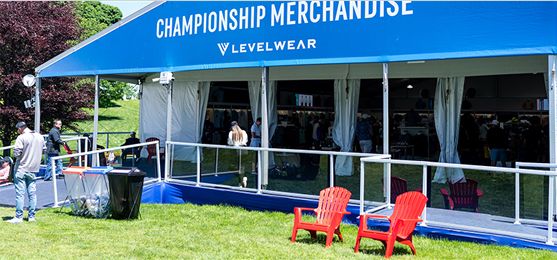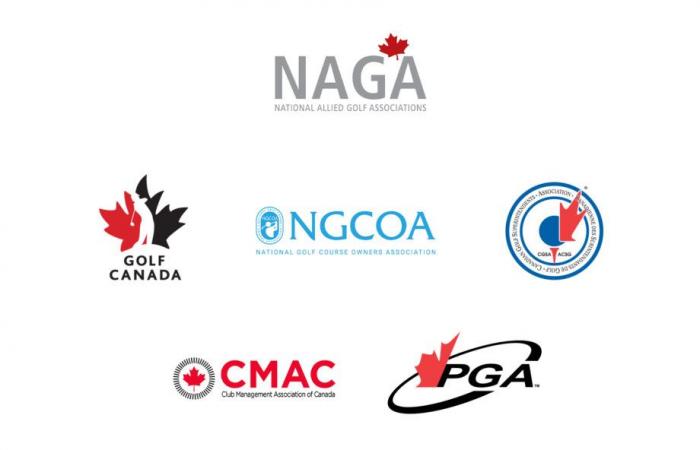Towards a sustainable game
Environmental management is a key element in ensuring a promising future for Golf across the country. This is why, as the national governing body for the sport, Golf Canada is committed to prioritizing sustainable development and reducing environmental impact and encouraging eco-responsible physical activity.
By combining natural landscapes, ecosystems and biodiversity, golf plays a positive role in the fight against climate change.
« Golf courses have 40% to 70% non-playable area. These large green spaces can be used advantageously to promote biodiversity as well as other naturalized solutions. »
*Based on a sustainability study commissioned by Golf Canada in partnership with the University of Waterloo (2023).
A victory for the environment
During the RBC Canadian Open and the CPKC Women’s Open, two of the largest golf tournaments in the country, Golf Canada once again demonstrated its environmental commitment by putting forward new ecological practices that protect the environment and reduce the carbon footprint.
-
Transport
To reduce the carbon footprint, shuttle and bicycle valet services were offered on site. This initiative made it possible to limit emissions from single-passenger vehicles when spectators travel.
-

Waste reduction and water management
More than 150,000 plastic water bottles were diverted from landfills and more than 21,000 gallons of water were consumed through refilling stations.
-

Protection of biodiversity
Through an active partnership with the golf course, plant nutrient management and reception structure planning helped avoid disruption of the animals’ natural habitats.
-

Renewable energy
In order to contribute to carbon neutrality, several methods promoting its capture have been put in place, including the use of batteries to power equipment, reception structures and media tents.
Golf Canada’s commitment to sustainability extends well beyond the RBC Canadian Open and the CPKC Women’s Open. In order to play ever greener, sustainable development initiatives have been integrated into daily activities through a partnership with clubs and leagues across Canada. Here are some examples:
- Implementation of recyclable take-out containers for players that help reduce the sending of plastic waste to landfills.
- Construction of water bottle refilling stations around the course or at the pavilion to encourage the reduction of personal waste.
- Increased the number of naturalized areas on courses to promote greater biodiversity and create a more engaging experience for players.
- Choice of electric golf carts that are less polluting than gasoline ones, which allows everyone to breathe easier.
Here is the game plan
Main sustainable development issues for Canadian golf

Biodiversity
What does this mean
Protect the vast flora and fauna that live on Canadian golf courses.
Why it matters
Golf courses have 40% to 70% non-playable area. These large green spaces are great sanctuaries that preserve biodiversity as well as wildlife and their habitat.
Pro tip
Do your part by respecting natural habitats along the way. To protect the wildlife and plants that thrive on non-playable areas, be sure to stay on the play areas and marked trails.

Water management
What does this mean
Pay great attention to the management of an essential natural resource.
Why it matters
The proper functioning of golf facilities requires a lot of water and this resource is carefully managed by maintenance professionals.
Pro tip
To clean your golf clubs and balls, use a damp cloth rather than water. It’s a small gesture that makes a difference and your equipment will always be at its best.

Energy efficiency
What does this mean
Reduce the carbon footprint by optimizing energy consumption.
Why it matters
It is essential to use energy efficiently in sport to minimize environmental impact. Reducing dependence on energy-intensive practices also means reducing our overall carbon footprint;
More and more golf courses are opting for electric equipment and carts as well as eco-friendly clubhouses to reduce energy consumption and carbon footprint.
Pro tip
Playing an 18-hole round of golf can burn up to 2,000 calories.

Waste management
What does this mean
Minimize waste on and off the course.
Why it matters
Poor waste management can harm the natural balance of golf courses which are valuable ecological spaces. Reducing your waste helps preserve air and water quality on the courses.
Pro tip
Use the trash cans provided at the starting area and at the pavilion. Bring your own water bottle to minimize single-use containers and use the recycling bins.
Focusing on sustainable development means guaranteeing an ever greener future for golf throughout Canada and ensuring its sustainability for all for years to come!
- Quality of the course : to continue to have memorable golf experiences, it is imperative to preserve the ecosystems that help maintain beautiful playing surfaces.
- Long-term pleasure : focusing on sustainable development ensures the sustainability of golf courses for generations to come.
- Health Benefits : Exercising by playing golf and spending time in an environment surrounded by lush vegetation and a thriving natural ecosystem is proven to result in mental and physical health benefits.
- Environmental Stewardship : focusing on sustainable development practices allows golfers of all ages to discover the importance of biodiversity and healthy ecosystems.
Sport at the forefront of sustainable development

#Canada















